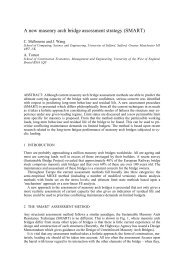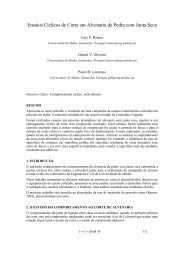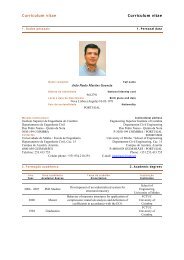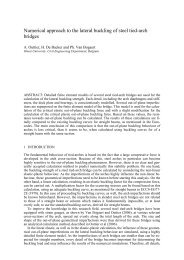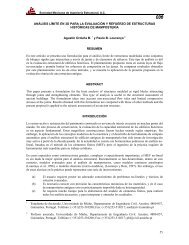Analysis of Flexible Pavement Distress Behaviors
Analysis of Flexible Pavement Distress Behaviors
Analysis of Flexible Pavement Distress Behaviors
You also want an ePaper? Increase the reach of your titles
YUMPU automatically turns print PDFs into web optimized ePapers that Google loves.
ANALYSIS OF FLEXIBLE PAVEMENT DISTRESS BEHAVIORS<br />
ABSTRACT:<br />
Abdullah Al-Mansour<br />
Pr<strong>of</strong>essor<br />
Civil Engineering Department<br />
King Saud University<br />
Riyadh, Saudi Arabia<br />
amansour@ksu.edu.sa<br />
The <strong>Pavement</strong> Maintenance Management System (PMMS) <strong>of</strong> Riyadh city perform<br />
comprehensive pavement visual survey prior to each maintenance program. In the condition survey<br />
detailed information related to type, severity and density <strong>of</strong> existing distresses was collected. The<br />
collected data was then used to determine needed maintenance activities on a project level. This<br />
process was proven to be costly and very time consuming.<br />
This paper utilizes the data <strong>of</strong> three pavement distress surveys over a period <strong>of</strong> six years to<br />
investigate and analyze the behavior <strong>of</strong> common types <strong>of</strong> pavement distress. The analysis included<br />
studying the factors affecting distress density. These factors included pavement condition, traffic level,<br />
severity level and time. In addition, the analysis involved correlation between distresses and<br />
propagation behavior and trend <strong>of</strong> common pavement distress types over time. The out put <strong>of</strong> these<br />
analyses can be used to predict distress data prior to each maintenance program. This will eliminate<br />
the need for comprehensive condition survey which proven to be costly and time consuming.<br />
INTRODUCTION<br />
<strong>Pavement</strong> distresses are visible imperfections on pavement surface. They are<br />
symptoms <strong>of</strong> the deterioration <strong>of</strong> pavement structures. Most, if not all, agencies that<br />
have implemented a <strong>Pavement</strong> Maintenance Management System (PMMS) collect<br />
periodic surface distress information on their pavements through distress surveys [1].<br />
<strong>Distress</strong> evaluation, or condition survey, includes detailed identification <strong>of</strong> pavement distress<br />
type, severity, extent, and location. To combine these details, an index is assigned to each<br />
pavement which is transferred to a general rating. Every highway agency either develops<br />
pavement distress evaluation procedure or selects a developed one for its pavement condition<br />
survey. Regardless <strong>of</strong> the size <strong>of</strong> the highway network or the sophistication <strong>of</strong> the PMS<br />
procedure, most PMS strategies can <strong>of</strong>fer assistance at two levels: the network level and the<br />
project level. Network level information provides management with broad-based data about<br />
the entire system. Information for planning purposes and fiscal analysis is <strong>of</strong>ten provided by<br />
the network data. On the other hand, project level information can include specific details<br />
about engineering design, construction and cost accounting. Obviously the data required for<br />
each level differs considerably. Network level required disaggregate data that reflects the<br />
general pavement condition. However, project level needs detailed and specific data on<br />
expected distresses.<br />
In general, distress density starts its propagation process very slowly, but it accelerates<br />
more at a later stage. There are factors that affect rate <strong>of</strong> propagation. These factors may<br />
include pavement condition, traffic levels and distress severity. The distress density<br />
propagation on a new or recently overlaid pavement sections having excellent condition is<br />
expected to be slower than on pavement sections with poor condition. A distress is expected<br />
to behave differently on pavement sections subjected to different traffic levels. Also, the<br />
distress severity levels have an effect on behavior and propagation <strong>of</strong> distress density.<br />
The <strong>Pavement</strong> Maintenance Management System (PMMS) <strong>of</strong> Riyadh city perform<br />
comprehensive pavement visual survey prior to each maintenance program [2]. In the condition survey,<br />
detailed information related to type, severity and density <strong>of</strong> existing distresses was collected. The<br />
1
collected data was then used to determine needed maintenance activities on a project level. This<br />
process is usually very expensive and time consuming.<br />
STUDY OBJECTIVE<br />
The main objective <strong>of</strong> this study is to investigate the behavior <strong>of</strong> the common types <strong>of</strong><br />
pavement distress on Riyadh’s street network. The analysis include determining factors affecting<br />
distress density, correlation analysis and propagation behavior <strong>of</strong> common pavement distresses.<br />
DATA BASE DEVELOPMENT<br />
Riyadh Municipality conducts comprehensive pavement condition evaluation prior to each<br />
maintenance program. The condition evaluation involves determining types, severity and density <strong>of</strong> all<br />
pavement distresses. The collected data was then converted to pavement condition index called Urban<br />
<strong>Distress</strong> Index (UDI). The UDI is a combined local index <strong>of</strong> fifteen pavement distresses developed for<br />
the Riyadh <strong>Pavement</strong> Maintenance Management System (PMMS). The index ranges from zero to 100,<br />
where 100 represents excellent pavement condition. The UDI is calculated based on pavement<br />
distresses type, severity and density for a specific section. Four pavement condition rating was adopted<br />
for the UDI system: Poor, Fair, Good and Excellent [3]. The Index has to be updated periodically to<br />
reflect the existing pavement condition. <strong>Pavement</strong> performance models were developed to update UDI<br />
on the network level [4]. However, the models did not predict changes in individual distress data. The<br />
condition <strong>of</strong> individual distress over time is very essential in planning maintenance activities on a<br />
project level.<br />
To date three comprehensive condition surveys were accomplished. The historical data was<br />
classified based on highway class into main and secondary streets. These surveys covered a period <strong>of</strong><br />
four years for main streets and six years <strong>of</strong> secondary streets. All pavement sections that received<br />
maintenance during the analysis period were eliminated. The remaining sections along with common<br />
distress data and date <strong>of</strong> inspection were stored in a separate data base for further analysis. The<br />
common main street distresses included in this study were: longitudinal and transverse cracks,<br />
weathering and raveling, potholes and depressions. The secondary street distresses included were<br />
longitudinal and transverse cracks, weathering and raveling and potholes [5]. The analysis involved<br />
590 main street data points and 3119 secondary street observations during each survey.<br />
FACTORS AFFECTING DISTRESS DENSITY<br />
Various factors may affect distress density. These factors include distress type, pavement<br />
condition, distress severity level, traffic level and time. To determine which <strong>of</strong> these factors affect<br />
distress density, analysis <strong>of</strong> variance was conducted. The ANOVA model has the following form<br />
DD = DT + PC + DS + AD + T<br />
Where,<br />
DD = percent <strong>of</strong> distress density<br />
DT = distress type (common types <strong>of</strong> distress)<br />
PC = pavement condition (excellent, good, fair and poor)<br />
DS = distress severity level (low, medium and high)<br />
TL = Traffic level for main streets only (high and low)<br />
T = time since first inspection in years.<br />
The distress density is calculated as the distress area divided by the surveyed area multiplied<br />
by 100 for all distresses. The distress quantity for longitudinal and transverse cracks, weathering and<br />
raveling and depressions are in square meters and for potholes is number <strong>of</strong> existing potholes in<br />
surveyed area. The output <strong>of</strong> this analysis is shown in Table 1. The analysis indicated that all factors<br />
2
have an effect on density <strong>of</strong> the individual distress in main streets and secondary streets except<br />
severity level for potholes. Pothole is localized type <strong>of</strong> distress and its severity level is not expected<br />
to affect the density <strong>of</strong> the distress. This is clear from the p-value <strong>of</strong> the ANOVA model.<br />
DISTRESSES CORRELATION ANALYSIS<br />
To investigate the effect <strong>of</strong> one distress on the others correlation analysis among all distresses<br />
was conducted. Table 2 shows the correlation matrix and probability values <strong>of</strong> the included distresses.<br />
The analysis indicated that longitudinal and transverse cracks and weathering and raveling distresses<br />
are highly correlated. That means one <strong>of</strong> these distresses leads to the existence <strong>of</strong> the other.<br />
Weathering and raveling correlates highly with depression and potholes. The existence <strong>of</strong> cracks,<br />
weathering and depressions on pavement surface indicate that potholes will appear in the same<br />
pavement section. The high value <strong>of</strong> correlations among the different distresses is an indication that<br />
existence <strong>of</strong> a distress on pavement surface is an inducement to other types <strong>of</strong> distress.<br />
ANALYSIS OF DISTRESS BEHAVIOR<br />
To investigate the propagation behavior <strong>of</strong> the common types <strong>of</strong> distress, the percent <strong>of</strong> each<br />
distress density was plotted against time <strong>of</strong> survey for all severity levels. These plots are presented in<br />
Figure 1 for main streets and in Figure 2 for secondary streets. It is clear that weathering and raveling<br />
is the wide spread distress among all the other distresses for both main and secondary streets. In four<br />
years period the percent <strong>of</strong> weathering and raveling density on main street increased by 100 %. This<br />
represents about 80% <strong>of</strong> the main street sampled area. In six years period about 70% <strong>of</strong> secondary<br />
street sampled area subjected to weathering and raveling. The percent density <strong>of</strong> weathering and<br />
raveling increased on secondary streets by about 250% in six years. The percent density <strong>of</strong><br />
longitudinal and transverse cracks increased by about 175% in four years on main streets and by about<br />
230% in six years for secondary streets. In four years, the percentage density <strong>of</strong> pothole increased by<br />
about 300% on main streets and by about 400% on secondary streets in six years. Potholes covered<br />
only 10% <strong>of</strong> the main streets sampled area in four years and 5% <strong>of</strong> secondary streets sampled area in<br />
six years.<br />
SUMMARY AND CONCLUSIONS<br />
This paper investigates the behavior <strong>of</strong> the common types <strong>of</strong> pavement distress on Riyadh’s<br />
street network. The analysis include determining the factors affecting distress density, correlation<br />
analysis and propagation behavior <strong>of</strong> common pavement distresses. The street network was divided<br />
into two main categories: main and secondary streets. The analysis utilizes data <strong>of</strong> three consecutive<br />
distress surveys. These surveys covered a period <strong>of</strong> four years for main streets and six years <strong>of</strong><br />
secondary streets. <strong>Pavement</strong> sections that did not receive any maintenance during these periods were<br />
only included in the analysis. The analysis involved 590 main street data points and 3119 secondary<br />
street observations during each survey. The common main street distresses included in this study were:<br />
longitudinal and transverse cracks, weathering and raveling, potholes and depressions. The secondary<br />
street distresses included were longitudinal and transverse cracks, weathering and raveling and<br />
potholes.<br />
The analysis indicated that distress type, pavement condition, distress severity level, traffic level and<br />
time all have a significant effect on density <strong>of</strong> individual distress in main streets and secondary streets<br />
except severity level for potholes. <strong>Distress</strong>es correlation analysis indicated that high value <strong>of</strong><br />
correlations among the different distresses. This is an indication that existence <strong>of</strong> a distress on<br />
pavement surface is an inducement to other types <strong>of</strong> distress. The distress behavior analysis proves<br />
that each distress has different rate <strong>of</strong> propagation with time. While weathering and raveling is the<br />
most spread distress, the percent <strong>of</strong> the distress density on main streets increased by 100 % in four<br />
years and by 250% on secondary streets in six years. The percentage density <strong>of</strong> potholes is increased<br />
by about 300% on main streets and represents only 10% <strong>of</strong> the sampled area in four years. In<br />
secondary streets the increased reached 400% and about 5% <strong>of</strong> the sampled area is subjected to<br />
potholes.<br />
3
REFERENCES<br />
1. Haas, R., et. al., "Modern <strong>Pavement</strong> Management", Krieger Publishing Company,<br />
Malabor, Florida, 1994.<br />
2. Al- Swailmi, S., E. Sharaf, A. Al-Mansour, S. Zahran, M. Al-Mulhem and AL-Kharashi,<br />
"Development <strong>of</strong> a Maintenance Management system For Riyadh Street Network", AR-<br />
15-02, Final Report 1418H (1998).<br />
3. Al- Swailmi, S., Al-Mansour, A., and et al “Developing Urban <strong>Distress</strong> Index for Riyadh<br />
PMMS”, Fifth Saudi Engineering Conference, UmmAl-Qura University, 1999.<br />
4. .AL-Mansour, A ., "Development <strong>of</strong> <strong>Pavement</strong> Performance Models for Riyadh Streets<br />
Network" Transportation Research Board (TRB), No.1655, 1999.<br />
5. Al-Mansour, A. and AL-Swailem, S. "<strong>Pavement</strong> Condition data Collection and Evaluation<br />
<strong>of</strong> Riyadh Main Street Network", Journal <strong>of</strong> King Saud University, Engineering Science,<br />
1997.<br />
4
Table 1. <strong>Analysis</strong> <strong>of</strong> Variance for <strong>Distress</strong> Density<br />
P-value<br />
Type <strong>of</strong> distress Factor Main<br />
Street<br />
Secondary<br />
Street<br />
Longitudinal and transverse<br />
cracks<br />
<strong>Pavement</strong> condition<br />
Traffic level<br />
Severity level<br />
Time<br />
.000<br />
.000<br />
.000<br />
.001<br />
.000<br />
N/A<br />
.006<br />
.000<br />
<strong>Pavement</strong> condition .001 .001<br />
Utility patching<br />
Traffic level<br />
.000 N/A<br />
Severity level<br />
NA .003<br />
Time<br />
.002 .001<br />
<strong>Pavement</strong> condition .001 .000<br />
Weathering and Raveling<br />
Traffic level<br />
.000 N/A<br />
Severity level<br />
.001 .021<br />
Time<br />
.000 .000<br />
<strong>Pavement</strong> condition .000 .002<br />
Potholes<br />
Traffic level<br />
.624 N/A<br />
Severity level<br />
.005 .135<br />
Time<br />
.000 .001<br />
<strong>Pavement</strong> condition .000 N/A<br />
Depression<br />
Traffic level<br />
.076 N/A<br />
Severity level<br />
.062 N/A<br />
Time<br />
.000 N/A<br />
5
Table 2. <strong>Distress</strong>es correlation coefficient and probability matrix for main and<br />
Secondary streets<br />
Highway class Longitudinal and<br />
transverse cracks<br />
Longitudinal Main St. 1<br />
and transverse<br />
cracks Secondary St. 1<br />
Weathering and<br />
1<br />
Main St.<br />
Raveling<br />
(0.013)<br />
0.985<br />
Secondary St.<br />
(0.109)<br />
0.999<br />
Main St.<br />
(0.024)<br />
Potholes<br />
0.998<br />
Secondary St.<br />
(0.043)<br />
0.996<br />
Main St.<br />
(0.058)<br />
Depression<br />
Weathering<br />
and Raveling<br />
1<br />
1<br />
0.998<br />
(0.037)<br />
0.971<br />
(0.153)<br />
0.994<br />
(0.072)<br />
Potholes<br />
1<br />
1<br />
0.999<br />
(0.034)<br />
Secondary St. N/A N/A N/A<br />
Depression<br />
1<br />
N/A<br />
6
percent distress density<br />
90<br />
80<br />
70<br />
60<br />
50<br />
40<br />
30<br />
20<br />
10<br />
0<br />
cracks<br />
weathering<br />
depression<br />
potholes<br />
0 2 4<br />
Time (Years)<br />
Figure 1. <strong>Distress</strong> propagation behavior on main streets<br />
percent distress density<br />
80<br />
70<br />
60<br />
50<br />
40<br />
30<br />
20<br />
10<br />
0<br />
cracks<br />
w eathering<br />
potholes<br />
0 4 6<br />
Time (Years)<br />
Figure 2. <strong>Distress</strong> propagation behavior on secondary streets<br />
7


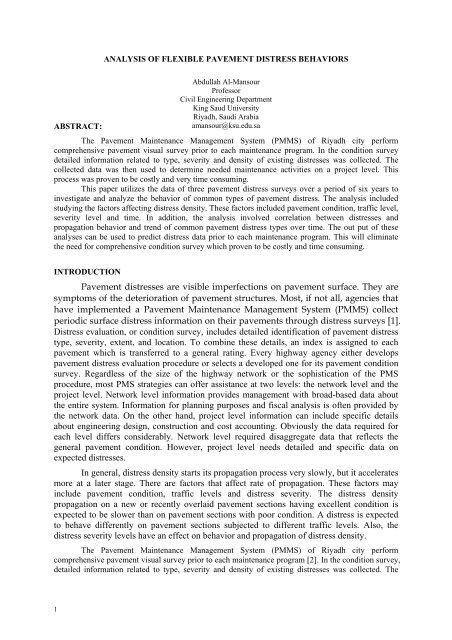
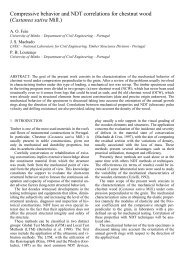
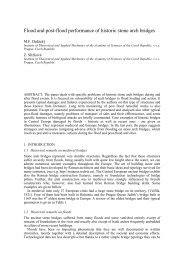
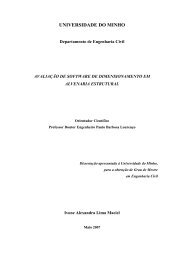
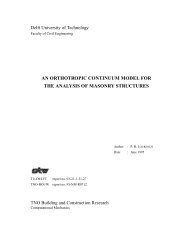

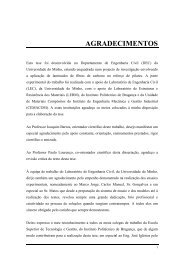

![Weibull [Compatibility Mode]](https://img.yumpu.com/48296360/1/190x134/weibull-compatibility-mode.jpg?quality=85)

